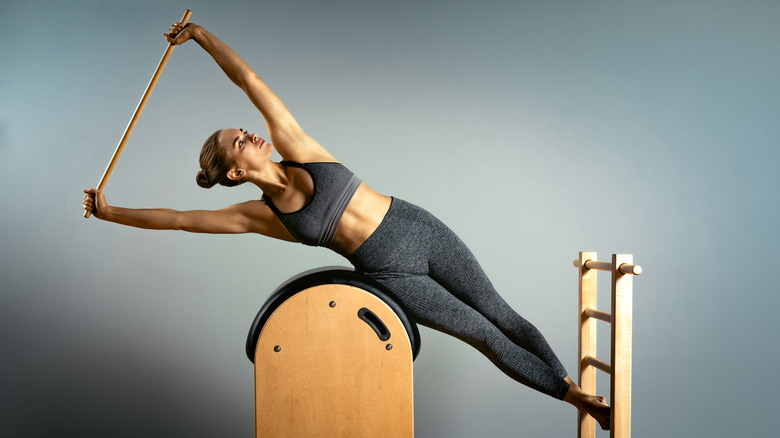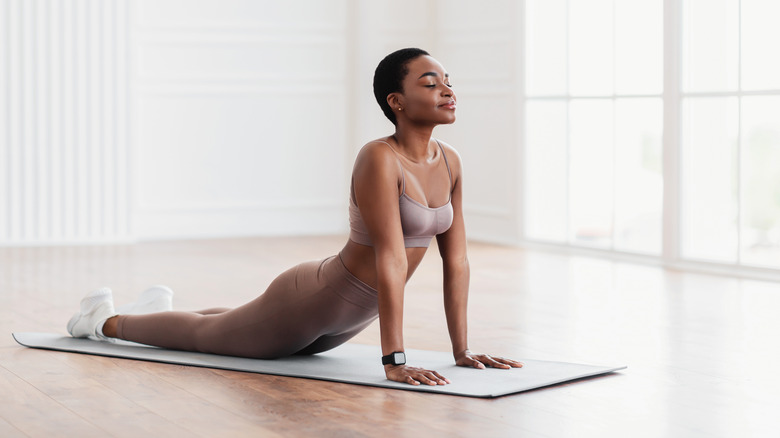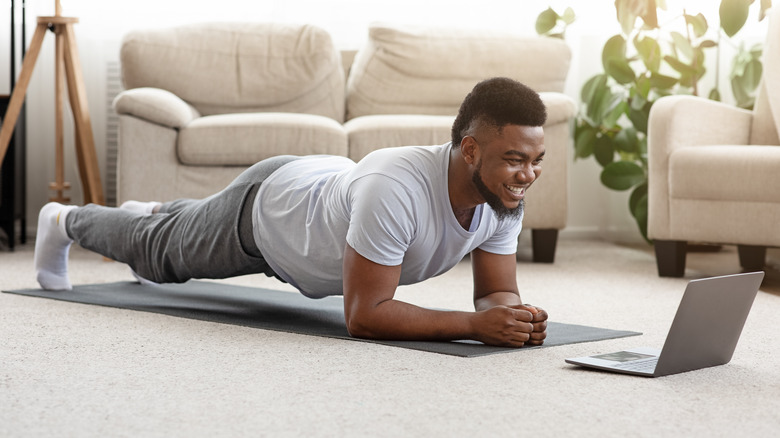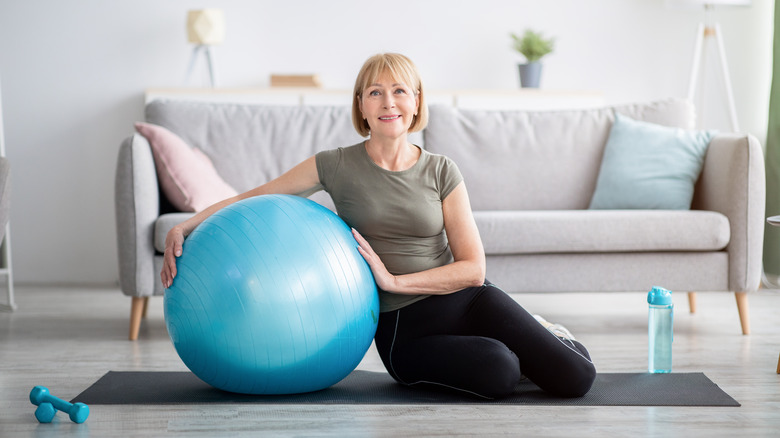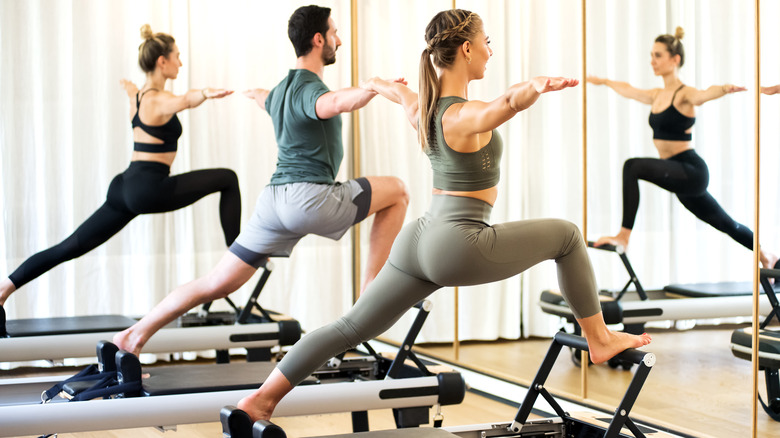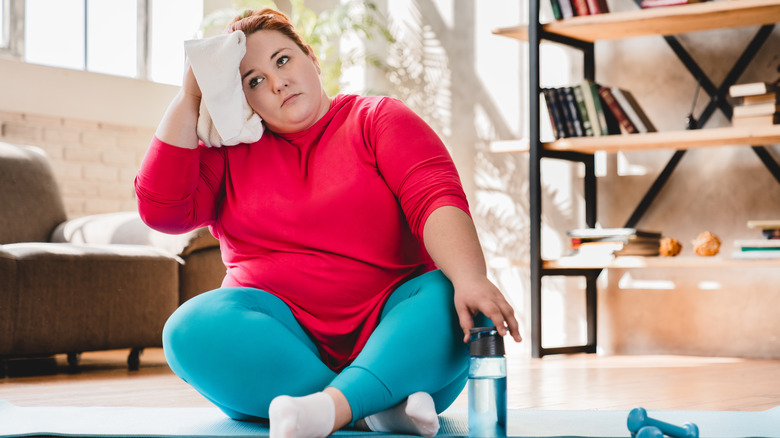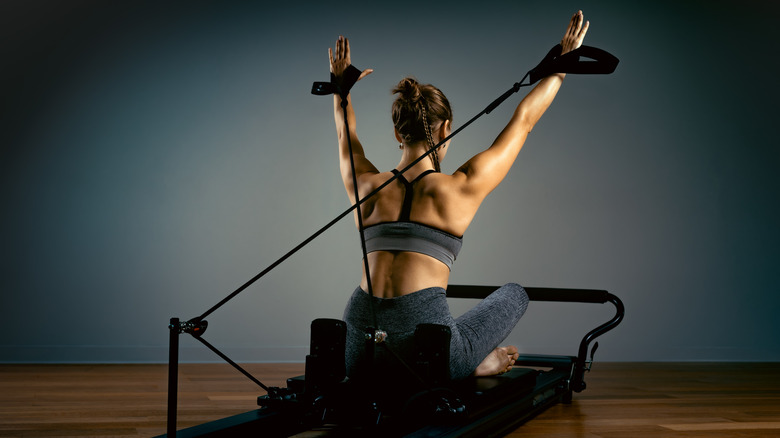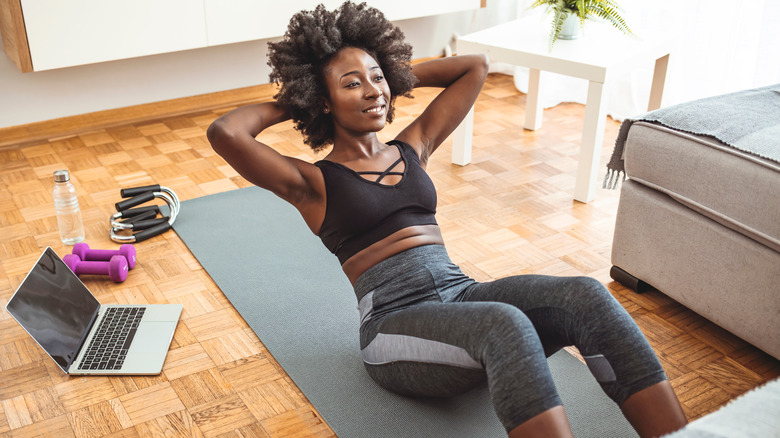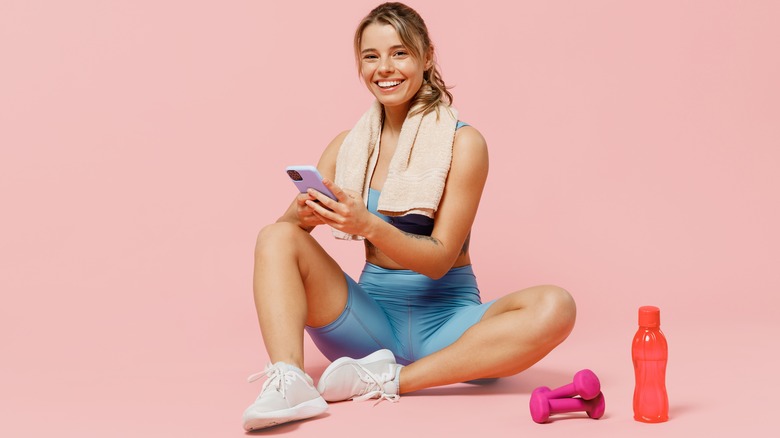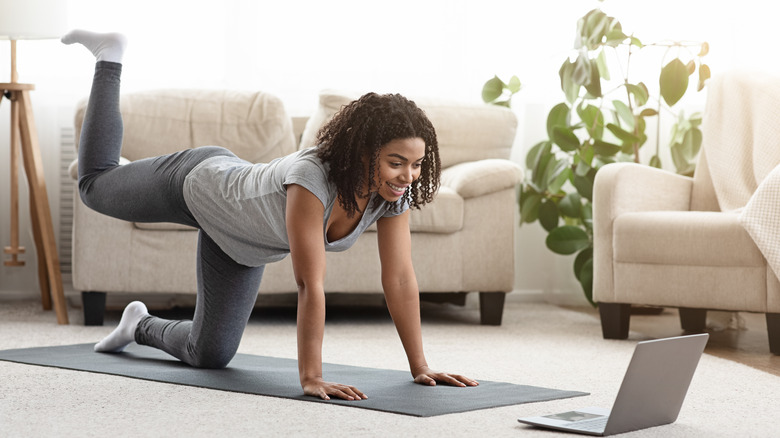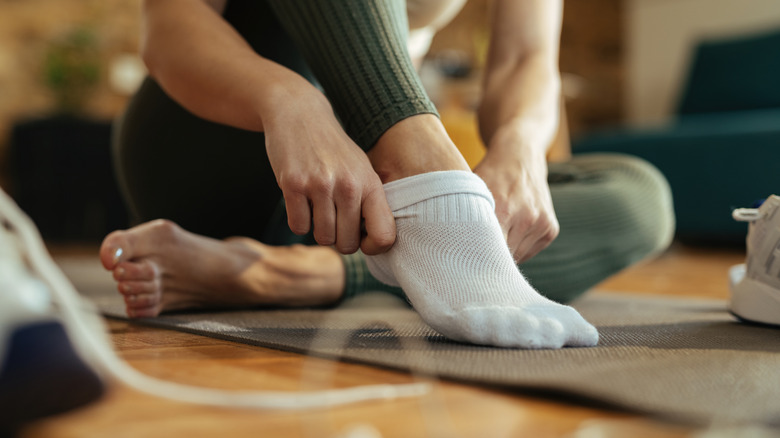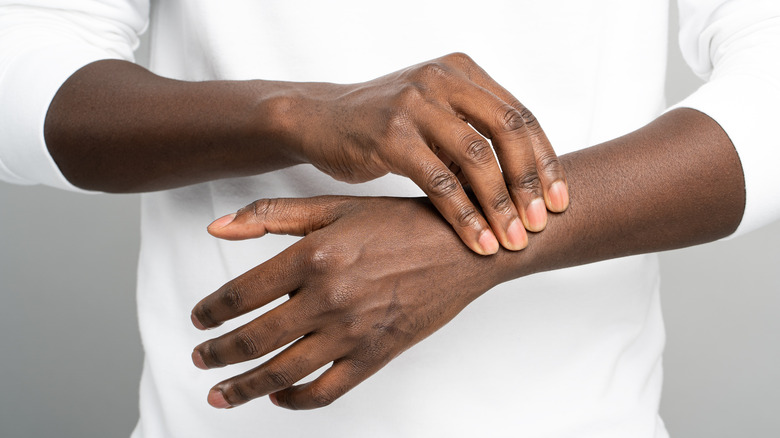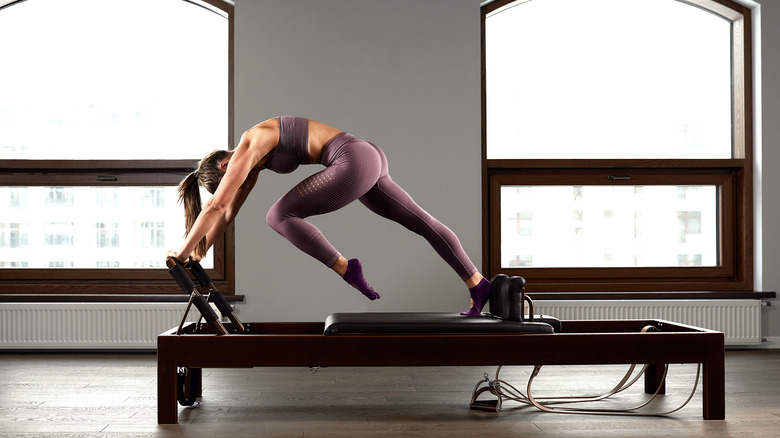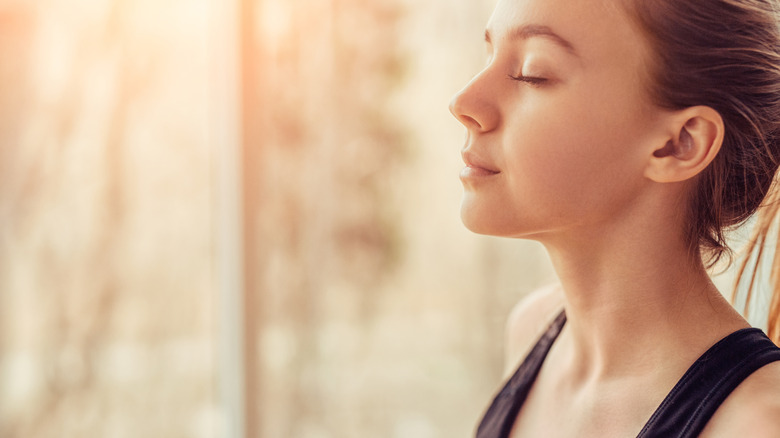Everything You Need To Know Before Starting Pilates
Let us ask you a question: What do you think you know about Pilates? If you're not one of the 12 million people who partake in Pilates worldwide (per the Pilates Foundation), you probably just think it's a bit of stretching, right?
Well, we're here to give you the full scoop. Pilates is a system of movement and exercise that is not only easily accessible and simple to start, but can give your body a serious workout. The low-impact exercise helps tone your entire body and increase your range of motion, and what's more, you can do it at any fitness level. "Pilates will meet anybody's needs to improve their movement in a graceful way, and at the same time make it extremely challenging. You can make so many variations of the same exercises that it stays fresh," says Gabriela Estrade, New Jersey-based Pilates instructor and ACE-certified personal trainer, to Self.
But if you've never done Pilates before, you can't be blamed for not really knowing what it is, and how it differs from other exercises. So for you Pilates newbies out there, we're cracking open the lid and explaining everything you need to know before your first class. Grab an exercise mat and read on.
Knowing the history of Pilates may help your approach to it
With any form of exercise, it's helpful to know the theory behind it, and what it's aiming to achieve — and with Pilates, knowing why it exists in the first place could help with how and why you practice it. Pilates was created by and named after Joseph Pilates, a German physical trainer who devised a system of exercise and fitness that was originally intended to help dancers recover from injuries (per the Cleveland Clinic).
After a while, however, more and more people started to key into the potential for Pilates to help with alignment and to gradually tone the whole body, helping keep it fit. "Our muscles get imbalanced because of overuse, and what Pilates does is help to counteract that," Judi Bar, lead yoga therapist, says to the Cleveland Clinic. Pilates practice centers on movements that are generated from the core of the body, with a specific focus on mental concentration during the exercises to help generate awareness of the body and its motion. Keeping your exercises slow, controlled, and specific, with breath flowing through the body with regulation throughout, helps with this mind-body connection.
Pilates isn't just about ab strength
Anyone who's ever seen images of a Pilates move, or videos of a class, will likely have a concept of how much your core gets involved. But it might be useful to know that despite popular opinion, Pilates isn't just about exercising your ab muscles. "Pilates is not restricted to specific body parts," says Black Girl Pilates founder and Pilates instructor Sonja Herbert to Self. Although Pilates does emphasize movements from the center of the body, "it is important that clients know that the core includes the entire trunk, which is the abdominals, the hips, the inner and outer thighs, and the back," Herbert says.
What's more, just because the core's generally involved doesn't mean that your upper body won't benefit from a Pilates session. Depending on the type of Pilates you're practicing, you might see moves like tricep extensions, band press outs, external rotations, or even tricep push-ups in your workout, all of which will help your upper arms and shoulders to tone up (per Women's Health). An intelligently designed full-body Pilates workout should leave your whole self feeling more toned and aligned.
Get to know the Six Principles
Before you start Pilates, it's useful to know what you're getting yourself in for, and that starts with how to approach it. There are six specific "Principles of Pilates" that underlie the exercise practice, and these were outlined in the book "The Pilates Method of Physical and Mental Conditioning" by Romana Kryzanowska, a student of Joseph Pilates, says Balance Moves.
The Six Principles are breathing, centering, concentration, control, flow, and precision. Breathing encourages you to focus on each breath and combine it with your movement, while centering reminds practitioners to focus on and move from the body's core. The principle of concentration instructs Pilates enthusiasts to maintain their attentiveness to their body throughout an exercise session, which ties into the fourth principle, control, which stipulates that all movements should be done with a sense of purpose, control, and rigor. Flow reminds exercisers to keep their movements fluid, moving into one another seamlessly instead of being jerky and sudden. As for precision: Make sure that your exercises are done with good form.
There are many different types of Pilates
So, Pilates is Pilates, right? Yes and no. While the system of Pilates is constructed around certain principles and styles of movement, the truth is that in terms of execution, there are loads of different kinds you can do. Most beginners will likely find themselves in a Mat Pilates class, which focuses on performing exercises using just a yoga mat and your body, with no equipment necessary, says Livestrong. A Classical Pilates class, built around Joseph Pilates' original teachings, will generally be composed of mat work and some exercises performed with equipment.
And here's where it starts to get interesting. Some Pilates classes use an apparatus called a Reformer, which kinda looks like a bed attached to a set of levels and springs. The Reformer machine adds resistance and challenge to any Pilates class. "The advanced form of reformer allows students to flow from one exercise to next with transitions. This enables constant movement and burns more calories," advises Life Time Athletic's Peak Pilates Comprehensive certified instructor Christina Pabon to Livestrong. Further developments in Pilates practice also led to the popularity of Winsor Pilates, Stott Pilates, and Contemporary Pilates, all of which add their spin on the exercise. Which one are you gonna try first?
Pilates may be gentler than other types of exercise, but it can still burn
It's all too easy to write Pilates off as a workout that's low-impact and low-intensity, and therefore low-result. But that's far from the case. Pilates works your body out through capitalizing on eccentric contractions, a specific type of muscle activation that happens when your muscles get longer while tensed, according to Verywell Fit. This leads your muscles to become fatigued and causes tiny tears to form in your muscle fiber, which in turn cause the tell-tale burn after a Pilates class (per Pilates Platinum). (And lest you worry that these small tears are a bad thing, know that they are actually necessary to the muscle-building process: As your body works to heal these micro-tears, your muscles will generate more tissue, making them stronger).
Naturally, how much you experience this ache depends on how hard you work your muscles, and this in turn depends on the intensity of the class you're doing. Some forms of Pilates, like Reformer Pilates, work with increased resistance and may result in a more strenuous workout. This aching after exercise, also known as delayed onset muscle soreness (or DOMS), will generally clear up within a few days and can be relieved by warm or cold baths, massages, and remaining active during the hours and days following a workout (via Healthline). And don't worry — unless your aches are really bad, it's usually just a sign of your body repairing itself and getting stronger!
You may not be using a Reformer straight away
So you've signed up for your first Pilates class, and you're excited to get on the Reformer. Sure, you kinda think it looks a bit like an old-fashioned loom, but you're up for the challenge. But don't get too excited: If you're a total newbie, it might be a while until you hit the Reformer, and it's not a bad thing to start with Mat Pilates instead. "Mat work is a great option for beginners because of its emphasis on learning how to control your muscles during exercises," says Winsor Pilates founder Mari Winsor to Gaiam. Winsor states that when you're new to the exercise, the focus should be on specificity, which can get lost if you go straight to a group Reformer session. "You need to be watched like hawk in the beginning," she adds.
It's also worth bearing in mind that Mat Pilates classes are often way easier to find than Reformer classes, and may well be cheaper to attend, too — and if you're not yet sold on Pilates as a practice, starting simple is the way to go. If you're dead-set on trying a Reformer class first, though, it could be worth looking for a private instructor or session to help guide you through using the machine correctly.
Warming up before Pilates is essential
With Pilates practice, it can be easy to assume that, because it's a lower-intensity exercise, warming up isn't necessary. After all, won't you just warm up while you're doing it? But warming up before a Pilates session — and really, warming up before any exercise — is vital to help prepare your body and stimulate blood flow to your muscles, helping you perform your movements with better efficacy, says the American Heart Association. If you're new to Pilates, it's also important to make sure your body's well-prepared and warmed up in order to minimize injury risk and aching muscles.
But the good news is that warming up for Pilates is a breeze, and a warm-up can often be incorporated into your session itself with some gentle Pilates movements. Try beginning your Pilates practice with a few wall roll downs to activate your spine and abs, as Verywell Fit suggests. Stand with your back against a wall and your feet walked slightly forward, and while engaging your abs, allow your head to nod against your chest. Let the weight of your head pull your spine down vertebrae by vertebrae, with your hips still touching the wall, until your body's folded in half. Then roll your body back up, your spine making contact with the wall again, until you're in your starting position.
It's best to dress for success
Okay, so let's be clear: We're not suggesting that you need to go out and buy a brand-new wardrobe to start Pilates. Fitness apparel is expensive, after all! But it's helpful to think about what you're wearing during a Pilates class beforehand, not least because it can affect how much your instructor can guide you in the right direction and keep an eye on your form, says Studio 44 Pilates.
When selecting pants or leggings, make sure that they're not too loose so your Pilates instructor can see your alignment properly. The same goes for the top you're wearing. In both cases, it's not necessary to wear anything skin-tight — just nothing too baggy. Layering your clothes is an excellent idea, as it ensures you can stay warm at the top of the class and later remove layers as needed to stay cool. Investing in a sports bra is a useful move to help support your breasts and prevent any tissue damage during exercise, Studio 44 Pilates states. And if you're planning on wearing shorts or anything loose on the bottom half, well, just keep in mind that you're going to be spending a lot of time on your back with your legs elevated ... so do with that information what you will!
You don't have to go to a live Pilates class to take part
We'll be the first to say that exercise classes can be intimidating, especially if you're going solo — and especially if you're doing something for the first time. But never fear! If you're a total beginner to Pilates, it's useful to remember that you don't even have to leave your home to try it out. "Virtual classes can be very ground-level and authentic, and can introduce you to studios where you can attend live classes if you feel comfortable later on," says certified Pilates instructor Gabriela Estrade to Self. Try and find a studio near you that has online options. If you warm to their style, you can try them out in person.
And the unstoppable rise of app-based fitness classes means that there are plenty of options for at-home Pilates programs that can be accessed straight from your phone. Open, Centr, and Obé Fitness all offer Pilates classes (some on-demand and some in live sessions, depending on the app). Or, just go straight to the reigning champs of the fitness world: Peloton. Far from just being a spin class company, Peloton has a range of exercise classes available, including Pilates, and is a great choice for folks who like to mix up their fitness. "The classes are convenient, well-paced, and easy to access, making them perfect for those who like all their exercise activities — cycling, weight training, yoga, HIIT — in one place," says Estrade (via Self).
Your choice of handwear and footwear is crucial
If you've settled on trying out a Reformer class, there are a few things you need to know. Not only is Reformer Pilates a more specialized version of the exercise, potentially requiring one-on-one input from an experienced trainer, but it'll also require you to hold onto the apparatus's bars or straps and use your feet to steady yourself (via Better by Today). And you don't want to be slipping around.
So, you may want to invest in some good hand and footwear. "Grippy socks and gloves also give you better grip even when you're not sweating, so you can focus on activating the proper muscles and not crunching your fingers or toes to stay in place," says Flex Studios Pilates instructor Elizabeth Heidari to MyFitnessPal. It's worth bearing in mind that in this more intense version of Pilates, you might find that you sweat more than you anticipate — and if you're trying to grip onto a bar with sodden hands, not only will it be pretty uncomfortable, but your form and workout may suffer. A solid pair of gloves can help eliminate this.
It's useful to brush up on your terms
So, once you've done your Imprinting and your C-Curve, jump straight on the Cadillac and we'll start to think about your Inner Eye. Confused yet? We don't blame you. Much like other exercise systems, Pilates has an abundance of terms specific to its classes, and although any Pilates instructor worth their salt will likely explain them in a beginner class, it doesn't hurt to get familiar with a few beforehand.
On the equipment side, the "Cadillac," "Reformer," "Megaformer," and "Wunda Chair" are machines used in Pilates classes to provide resistance and adapt exercise approaches (via Women's Health Magazine). Your "Powerhouse" refers to the center of your body, comprising your abs, glutes, hips, and lower back. If you hear your instructor talk about your "Midline," they're referring to the line that goes from your feet to the crown of your head. And if you're asked to practice "Lateral Breathing," it means you're being advised to focus on breathing into your side ribs. This is just a starting point, of course — as you take part in more Pilates classes, you'll become more familiar with its terminology. A whole new vocabulary awaits you!
Your wrists may feel the impact
Although Pilates is, by its very nature, a gentler way to get toned, you may feel it in certain body parts more than others. One area that takes a little extra strain is your wrists. Certain Pilates classes have multiple moves that involve propping up our bodies with our hands on the floor, like planks, cat stretches, and the superman, says Good Country Physiotherapy. As these positions require weight-bearing on your wrists in a non-functional position, this may cause either acute or long-term strain.
However, there are adjustments you can make to help lighten the load on your wrists. Try and ensure you are spreading weight through your hands evenly, connecting to the floor with each knuckle and keeping your hand flat, advises Freshly Centered. It can help to spread your fingers out as wide as possible, too. In any position where your hands are on the floor, make sure that your arms aren't extending over them, or leaning back — your arms, hands, and shoulders should all be aligned. And remember, if your wrists are feeling strained or you have a pre-existing wrist injury, see if you can adjust the move to perform it resting on your elbows instead.
When you're doing a Reformer class, listen carefully to your instructor
If you've ever done an exercise class before, you might be familiar with some Pilates or Pilates-esque moves, which makes transitioning to a regular Pilates class pretty easy. But Reformer Pilates? That's a whole other ball game. The Reformer, a classic piece of Pilates apparatus made of a sliding platform with ropes, pulleys, and handles, is used to add resistance during standard moves, and can also be a part of rehabilitation programs, says Studio Pilates.
But if you're just starting on a Reformer, you need to give your instructor the floor. "Listening to the instructor first should give you a good indication of where you'll be on the machine," advises Pilates instructor Elizabeth Heidari to MyFitnessPal. Pay attention to their guidance while they lead you through the different moves, resistance levels, and where to focus your attention. This will help you to maximize your workout, familiarize yourself with the machine, and avoid injury. Remember to breathe and keep movements slow and controlled. And above all, don't go too big! "My biggest tip when I talk to newbies is that a lot of the stuff that we're asking you to do in our space is a lot smaller than you think. Pilates is the little muscles," Heidari says via Shape. Smaller movements activate your deep musculature, and it's this you're trying to train.
Don't forget the importance your breathing technique
How nice is it to sometimes just stop and breathe? Honestly. Take a deep breath right now. You'll thank us for it. But sometimes during exercise, and particularly when starting a new activity, our breathing can go out of the window as we focus on our movement and form.
When starting Pilates, though, it's important to remember that breath is not only vital to, well, keep you alive, it's also an integral part of the exercise practice itself. In and out breaths should be cleanly synchronized with movement during Pilates, says Studio Pilates. Furthermore, the type of breathing you do is integral to proper muscle activation. The breath should be focused on your diaphragm and oblique muscles, as opposed to your chest — meaning that when you breathe, the sides of your ribcage should expand and contract. Breathing in this manner allows your lower back to remain protected during your movements and facilitates proper abdominal activation, and keeps your neck and shoulders free from tension.

